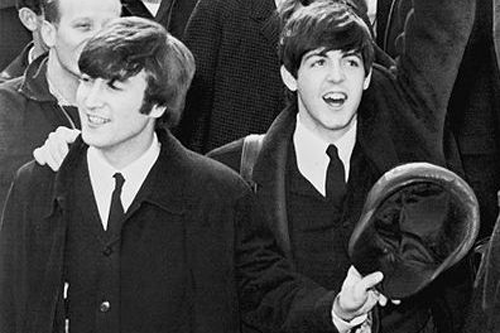
Joshua Wolf Shenk’s Powers of Two: Finding the Essence of Innovation in Creative Pairs (Houghton Mifflin Harcourt) offers a compelling new way to look at creativity. Shenk wants to put to rest the “lone genius” myth, our romantic vision of the single mind at brilliant work as if by magic or divine intervention. In order to do so, he focuses on the creative collaborations of dynamic pairs who have produced some of our most exciting innovations in the arts and sciences, including John Lennon and Paul McCartney, Suzanne Farrell and George Balanchine, Simone de Beauvoir and Jean-Paul Sartre, Steve Jobs and Steve Wozniak, Theo and Vincent Van Gogh, and Marie and Pierre Curie.
Shenk, through his study of hundreds of creative pairs, has been able to trace a pattern or progression in the trajectory of a successful dynamic duo. He spells out the six stages of creative collaboration in his introduction, and the text offers examples and further analysis. The phases of an innovative dyad’s creative life cycle are as follows:
- Meeting: This is the moment that brings about the spark—the chemistry or electricity that leads two people to form a creative pair.
- Confluence: Over time the members of the pair shift from being two individuals interested in each other to a dyad with a shared identity.
- Dialectics: As the pair gets into the hum of creative work, a dance or negotiation ensues where each person takes on a distinct archetypal role that counterbalances the other.
- Distance: For any creative pair, long-term endurance and success requires time and space apart in order to cultivate distinct ideas and experiences that can be shared later, to give the pair what Shenk calls “ongoing frisson.”
- The Infinite Game: When producing their best work, the two interact with each another through both competition and cooperation, opposing modes that are fundamental to success.
- Interruption: A creative pair breaks up not because of a lack of spark, but rather due to a loss of balance, which can often be about the larger context of their work.
The six stages of a creative pair’s work together can unfold in a variety of ways depending on the partners in question. Sometimes the initial meeting is felicitous, a kind of love at first sight, and at other times the foundational spark is based on conflict, as in the case of Sergey Brin and Larry Page. Some partners must negotiate the dialectics of creativity and romance at the same time, for example Marie and Pierre Curie. In some cases, even when a pair no longer collaborates, their identity as a creative “we” can remain potent and alive far into the foreseeable future, which rings true for John Lennon and Paul McCartney.
My favorite pair in Shenk’s book is Suzanne Farrell and George Balanchine, in part because their creative innovation and negotiation involved the physical body through dance, and in part because Farrell never accepted Balanchine’s romantic overtures and thus was able to transform her position in the dyad. Farrell went from serving as Balanchine’s ethereal feminine muse to being an independent and powerful woman who was also his collaborator. The shift in their relationship took place only after Farrell and Balanchine got back together following a dramatic creative split that seemed earth-shattering and permanent in the moment it occurred. Shenk writes: “But things had changed. A new, more durable, more reliable tension existed between them that allowed for a new kind of closeness.”
Powers of Two is a book that offers inspiring historical narratives starring outsize personalities and big stakes, but there is something within its pages for all of us to glean. I am very drawn to the question Shenk asks the psychologist Esther Perel, author of Mating in Captivity: Unlocking Erotic Intelligence (Harper Perennial), and her unequivocal answer. He wants to know “whether sharp distinctions can be drawn between physical and creative desire,” and her answer is, “Of course not.” For this reason, I believe that Shenk’s book illuminates our creative work and our creative play, our professional and personal relationships, as well as the fascinating and often unchartered territory in between.
Click here to see Rose’s tips for healthy and happy relationships


